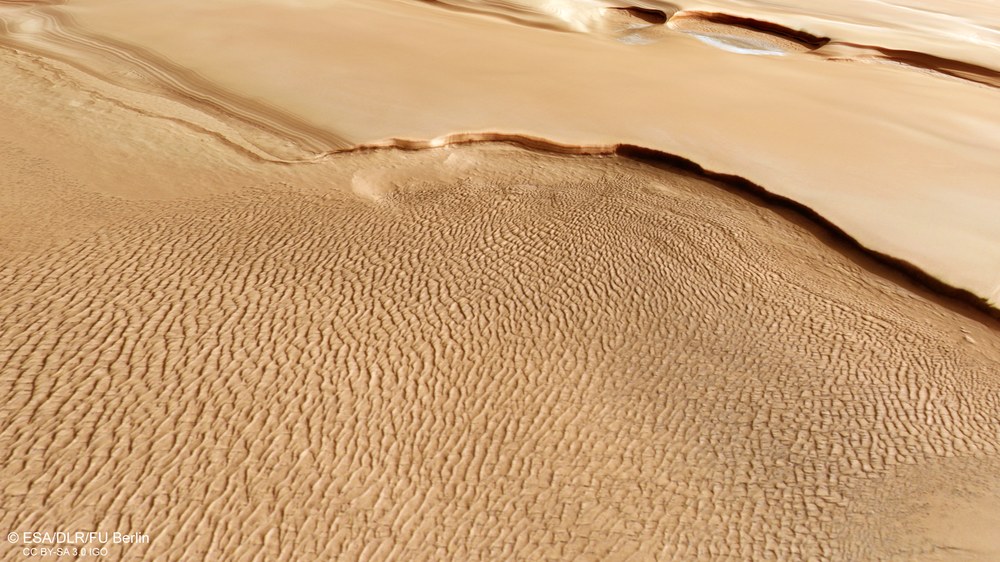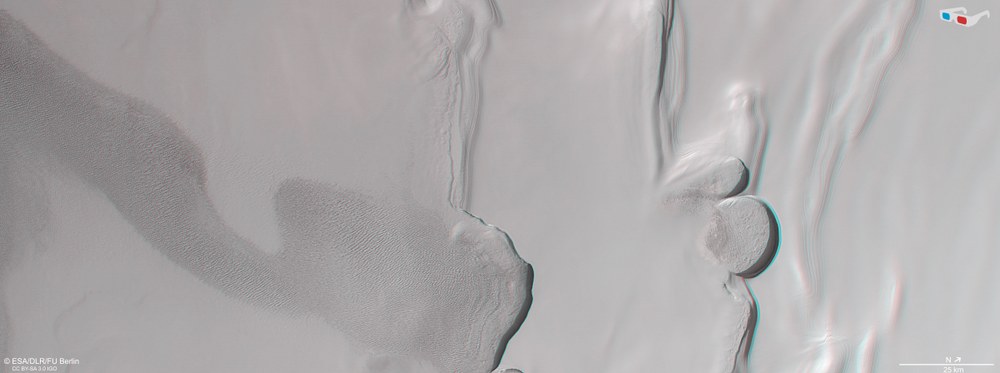Olympia Planum – between dunes and steep ice cliffs



- Dust-covered layers of ice at the North Pole serve as a climate archive for Mars.
- Mars' North Pole is covered by a three-kilometre-thick 'dusty ice cap'.
- Thousand metre high cliffs provide a view of geological structures.
- Focus: Spaceflight, planetary research, Mars
These images, created using data acquired by the High Resolution Stereo Camera (HRSC) developed and operated by the German Aerospace Center (Deutsches Zentrum für Luft- und Raumfahrt; DLR) on board ESA's Mars Express spacecraft, show a section of the Olympia Planum region, an area close to the permanent ice cap of Mars. Here, several steep scarps mark the boundary between the north polar ice cap and the lower-lying surrounding terrain with large dune fields. These vertical ice walls are up to 1000 metres tall and provide a Martian climate archive.
HRSC has been mapping Mars at high resolution, in three dimensions and in colour since 2004. Its data is an important resource for current and future Mars research. The study of the high northern and southern latitudes with their seasonally growing and shrinking ice caps is particularly important for deciphering the planet's recent geological past and ongoing atmospheric processes.
Changes on the surface of Mars through the seasons
Mars’ permanent north polar ice cap is a stack of water ice and dust layers up to three kilometres thick and approximately 1000 kilometres in diameter. These are divided into four stacked 'packets' of different thicknesses, which in turn are made up of finer layers. These layers contain information about the climate dating back several million years in the history of Mars. The deposits were formed by atmospheric precipitation of dust and water ice (in the form of snow) and by direct frost formation. They consist mainly of water ice, with fine dust sediments making up between 10 and 15 percent of the total. They probably reflect changes in the orbit of Mars and the inclination of the planet's axis of rotation, whose orientation is much more unstable than that of the Earth. It varies in several cycles with periods ranging from a few thousand to a few million years. The varying solar radiation results in a strongly varying climate, especially at the poles. It is assumed that the north polar ice cap is currently growing.
During the six-month Martian winter, an additional layer of carbon dioxide ice forms over the permanent water ice cap. The carbon dioxide precipitates out of the atmosphere and then sublimates completely in summer. As the planet's axis of rotation is tilted by 25 degrees – Earth's is approximately 23 degrees – in relation to its orbital plane around the Sun, Mars also has distinct seasons. However, due to its two-year orbital period, they are twice as long as on Earth. As on Earth in the Antarctic and Arctic regions, there are long polar nights with temperatures of down to minus 130 degrees Celsius. The images shown here were created using data acquired last spring in the northern hemisphere, where it is currently polar night, and the winter solstice is on 7 June 2024.
The polar cap itself has a smooth and pristine surface with some visible layers, but no impact craters. This means that the surface is very young and is probably covered with a new layer of dust every Martian year.
The extraordinary 'spiral arms' around the North Pole of Mars
Also clearly visible in the images are two semi-circular cliffs, the larger of which has a diameter of 20 kilometres. They are located in what is referred to as a polar trough, a morphological feature created by the erosive force of the wind. These clockwise-oriented troughs create the characteristic spiral pattern of the polar plateau.
The cliffs in these HRSC images show a vertical wall of layered ice over one kilometre high in some places. The strong shadows cast emphasise their steepness. This becomes particularly clear when viewing the 3D image. Traces of pronounced erosion can be seen at the foot of the cliffs, exposing further layers. The areas within the trough are littered with large, frost-covered dune fields. Where the dunes are not covered by a layer of frost, they have a dark, grey-black colour.

Dunes as far as the eye can see
The elongated dune field shown in the pictures stretches for more than 150 kilometres. It is clear that the sands that form this dune field originate from the erosion of the polar deposits on the large scarps visible here. The morphology of the dunes also indicates the direction of transport of the sands, away from the cliff towards the south. This larger, more southerly dune field is not covered by a layer of frost, but by a thin layer of dust, which gives the dune field its brownish colour. At a greater distance around the north polar region are the Olympia Undae, the 'Waves of Olympia', a huge dune field that stretches over an area of 470,000 square kilometres between 78 degrees and 83 degrees north. This area is approximately the size of the entire Balkan Peninsula. Dark dune fields are very common on Mars, for example on the floor of numerous impact craters. However, the dunes found at the North Pole are special due to their mineralogical composition.
Back in 2005, shortly after the Mars Express orbiter arrived at Mars, the Observatoire pour la Minéralogie, l'Eau, les Glaces et l'Activité (OMEGA) instrument, a spectroscope for determining the mineralogy of the Martian surface, discovered high concentrations of gypsum (calcium sulphate with water molecules in the crystal lattice) on the dunes of Olympia Undae. These dunes are a fascinating object of study due to their unique gypsum composition, their proximity to polar ice deposits and their seasonal fluctuations. The High Resolution Imaging Science Experiment (HiRISE) on NASA's Mars Reconnaissance Orbiter has been acquiring high-resolution images of Mars since 2006 (but unlike the HRSC, not in 3D and not with its large area coverage). A particularly impressive view of steep layered slopes near the North Pole is shown this image of slipping boulders from May 2014.
Image processing
These images were created using data acquired by the High Resolution Stereo Camera (HRSC) on 14 April 2023 during Mars Express orbit 24354. The image resolution is approximately 21 metres per pixel. The centre of the imaged area is located at approximately 231 degrees east and 84 degrees north.

The colour image was created using data acquired by the nadir channel, the field of view of which is aligned perpendicular to the surface of Mars, and the colour channels of HRSC; the oblique perspective views were computed from data acquired by the stereo channels of HRSC. The 3D image (anaglyph image), which gives a three-dimensional impression of the landscape when viewed with red-blue or red-green glasses, was created using data acquired by the nadir channel and the stereo channels. The colour-coded image is based on a Digital Terrain Model (DTM) of the region, from which the topography of the landscape can be derived. The reference body for the HRSC DTM is an equipotential surface of Mars (areoid). The systematic processing of the camera data was carried out at the DLR Institute of Planetary Research. Personnel from the Department of Planetary Sciences and Remote Sensing at Freie Universität Berlin created the image products shown here.
Related links
The HRSC experiment on Mars Express
The High Resolution Stereo Camera (HRSC) was developed at the German Aerospace Center (DLR) and built in cooperation with industrial partners (EADS Astrium, Lewicki Microelectronic GmbH and Jena-Optronik GmbH). The science team, led by Principal Investigator (PI) Daniela Tirsch from the DLR Institute of Planetary Research, consists of 52 co-investigators from 34 institutions and 11 nations. The camera is operated by the DLR Institute of Planetary Research in Berlin-Adlershof.
